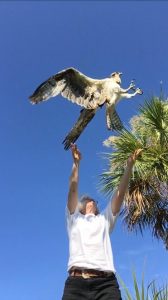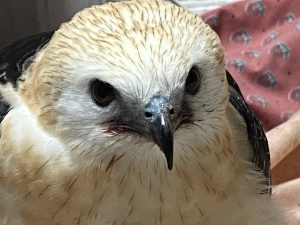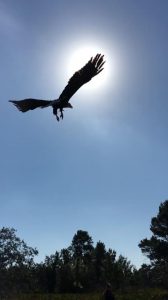
All photos courtesy Raptor Center of Tampa Bay
Like a phoenix, Tampa Bay’s first full-fledged rescue and rehabilitation center for raptors is rising from an abandoned fish farm in Riverview.
With the closest facilities now located in Fort Myers and Maitland, it’s a long-needed resource for raptors like eagles, owls, ospreys and hawks, said Nancy Murrah, president of the Raptor Center of Tampa Bay (RCTB). Over time, the 1.2-acre site will include a 100-foot flight cage for eagles and other large birds, several 60-foot cages for smaller birds, an avian veterinary clinic, meeting space for educational events, and a gift shop. It’s the culmination of a multi-year effort to create a center dedicated to birds of prey.
Already this year, Murrah and her team have rescued 600 animals including 10 bald eagles, 57 screech owls, 11 great horned owls, 77 red-shouldered hawks, a white-tailed fawn and even several opossum. “The goal is to bring them back to health and then recondition them so they can be returned to the wild with the best possible chance of survival.”
The flight cages are critical to the reconditioning process because the birds’ muscles atrophy while they’re recovering and they need to rebuild their strength before they’re released, she said. The 100-foot cages are required by law. Most raptors, including bald eagles, are highly territorial. “Fights are a primary reason that they’re injured and here in the first place so they need plenty of room.,” she said.
Nesting season – the busiest time of the year for bird rescues – is winding down now but RCTB is moving into action for next year. They were able to purchase 18 stainless steel cages to use instead of dog crates, a stainless steel exam table, an autoclave and even a human-sized incubator from a closed veterinary office.
The center runs with a team of committed volunteers who coordinate everything from laundry and medical supplies to a tree climber who builds platforms to strengthen the nests of raptors when one of the nestlings falls to the ground.
“He builds a platform near the nest that’s usually falling apart, and puts a sibling on the platform with the rescued chick,” she said. “The parents usually watch from a nearby tree and they seem happy to move into the safe and secure new home he built for them.”
Birds that can’t be returned to their parents are raised until they’re old enough to hunt on their own and then tested on live prey to make sure they’ll be able to survive in the wild, she adds.

Some birds, like a female great horned owl with a cranial nerve problem, can’t be released but she has turned out to be a great foster mother for the five owl chicks that were rescued this spring. “She can’t balance on a perch for long, but she taught them to hunt so they’re more likely to be successful when they’re released,” Murrah said.
The overall success rate for RCTB is 42% rescued, rehabilitated and released but some species do better than others. Sandhill cranes, among the birds most comfortable living in suburbia, only survive about 10% of the time if they’re injured and need to be rehabilitated. “They’re very friendly in the wild, but they’re a lot different in a cage,” Murrah said. “In the wild, they wander all day, which they can’t do in a cage and it causes so much stress that they stop eating.”
That said, Murrah adds quickly, some juveniles do very well and can be successfully reared and released once they’re old enough to forage for food on their own.
Help Wanted!
 While volunteers who are comfortable handling large animals with sharp beaks are always needed, RCTB also needs volunteers who are leery of large birds.
While volunteers who are comfortable handling large animals with sharp beaks are always needed, RCTB also needs volunteers who are leery of large birds.
Corporate sponsors are needed to fund the flight cages that are necessary to rehabilitate injured birds, with costs ranging from $60,000 to $100,000, depending upon the size.
An immediate need is people to help repurpose the buildings and outbuildings at the new facility in Riverview. “Volunteers, including a squadron from MacDill came down to gut one of the buildings and clear parts of the driveway that haven’t been used in years,” Murrah said. The main building, basically a large rectangle, needs to be renovated to include a clinic, bathrooms for volunteers and rooms for the birds. Another building needs a new roof, and a carport needs to be enclosed to shelter permanent residents.
Another important need is for transporters because birds from much of central and southwest Florida will end up in Tampa. “I’m working now to get a bird from Sebring,” Murrah said. “We had stops in Frostproof, Fort Meade and Plant City before it ended up in Brandon. We keep the rides relatively short so that one person doesn’t have a long distance to travel.”
People who can help with educational efforts and fundraising also are appreciated. “We have a great graphic artist but we really need a designer to rebuild our website. And planning for the next Wonders of Wildlife festival, the center’s major fundraiser, already is underway.”
